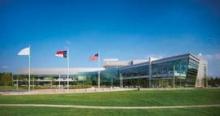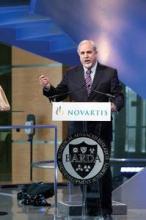With the official dedication Dec. 12 of America’s first facility for making influenza vaccine in cell culture, the United States took a small but important step toward improved protection against the next flu pandemic, experts said.
But some question just how many weeks this new facility will shave off of the timeline for moving from a candidate pandemic vaccine strain to getting the vaccine into the arms of the American public. And by relying on an inherently old-fashioned approach to flu protection with limited effectiveness, some see this development as merely refining an archaic vaccine that is overdue for replacement by a newer and better method of immunoprotection against pandemic influenza.
"It’s a small, incremental step in preparedness, but the current hemagglutinin-antigen based vaccine really is inadequate for providing the kind of immunologic protection we need, and so anything you do to speed up the amount of [this type of] vaccine is only a marginal improvement in protecting against influenza," commented Michael T. Osterholm, Ph.D., professor in the school of public health and director of the Center for Infectious Disease Research and Policy at the University of Minnesota, Minneapolis.
"Just because you can make more of this [vaccine] faster, what does that mean? It’s better than nothing, absolutely, but that doesn’t mean it will be the answer for a very serious pandemic," Dr. Osterholm said in an interview.
"Having a new facility of substantial production capacity in the United States is a comfort," said Dr. William Schaffner, professor of medicine and chairman of preventive medicine at Vanderbilt University, Nashville, Tenn. "When you’re creating a pandemic vaccine, every week counts," and the cell culture–based technology that the new plant employs "is supposed to be somewhat faster" than conventional, egg-based production of flu vaccine, he noted. By not relying on chicken-based egg production that might conceivably be vulnerable to an avian flu pandemic, the new facility also sidesteps that potential danger.
"Having this facility in the United States is a significant step, as is having more vaccine," he said.
The new vaccine plant, in Holly Springs, N.C., culminates a 7-year project by Novartis working on contract with the Health and Human Services department, which funded 49% of the construction costs. The new plant brings cell-based flu vaccine production into the United States, and eventually onto the U.S. vaccine market for the first time, and also serves to beef up U.S.-based flu vaccine production of all types.
HHS officials first envisioned the new facility in 2004, when the American flu vaccine supply became threatened by many previous manufacturers going out of business, and when the supply from British-based Chiron temporarily went off line, said Robin Robinson, Ph.D., director of the HSS Biomedical Advanced Research and Development Authority. The facility uses cultured canine kidney cells to grow influenza vaccine.
The Holly Springs plant first became operational in late 2009, and now has produced several commercial-scale lots that have undergone testing in Phase III trials, Dr. Robinson said in an interview. The facility is positioned to immediately start making as much as 50 million doses of pandemic flu vaccine using cell-culture production, which could receive emergency-use FDA licensing and be available to the American public.
In the absence of a pandemic, the facility will primarily focus on making seasonal influenza vaccine (as well as certain other vaccines), but with much less urgency. The seasonal vaccine will undergo less speedy FDA licensing and will likely not appear on the U.S. market until 2013 or 2014, he said. Currently, U.S. residents received roughly 130 million doses of seasonal flu vaccine annually.
For pandemics, a major goal of cell-based flu vaccine production is to have "more vaccine available sooner," Dr. Robinson said. "The goal is 4 months" once a candidate vaccine strain is isolated during a new pandemic, but a more realistic expectation is that facility will send out significant amounts of vaccine after "4-5 months," he said. That compares with the 5 months it took to have the first egg-based vaccine appear during the H1N1 pandemic of 2009, he noted.
"If a pandemic happened now, and if everything went right, we’d cut the time to vaccine by about 1 month. That would have a huge impact. We hope it would eliminate the confusion" and the rationing that characterized the first weeks of pandemic vaccine availability in 2009, Dr. Robinson said.




